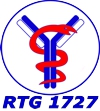associated TP31: The role of the C5a/C5aR1 axis for the development of maladaptive immune responses in experimental epidermolysis bullosa acquisita
Epidermolysis bullosa acquisita (EBA) is an aquired subepidermal blistering disease caused by autoantibody-mediated immune responses targeting collagen type VII (ColVII), which is the major component of the anchoring fibrils (AF) located between the basal membrane and the dermis in the dermal epidermal junction zone (DEZ). AF are in charge of securing the tight connection between the dermis and the epidermis.
Autoantibodies in EBA show a wide diversity in targeted epitopes whereby, autoantibodies against the van Willebrandt Factor A2 (vWFA2) domain of ColVII seem to be crucial in its pathogenesis. In EBA, the DEZ is perturbed, breaking up its integrity thereby leading to the typical blistering phenotype induced by complement-activating IgG autoantibodies. An experimental mouse model has been established mimicking the human condition by eliciting an active immune response against ColVII through injection of the vWFA2. The animals develop severe skin blistering associated with the generation of vWFA2-specific IgG antibodies and deposition of C3 cleavage fragments in the DEZ.
Here, we aim to define the role of the C5a/C5aR1 axis for the development of vWFA2-specific autoantibodies in the active model of EBA. We hypothesize that the C5a/C5aR1 is required for the development of plasma cells from vWFA2- specific B cells. We further hypothesize that the impact of C5a is either mediated through local complement activation in the draining lymph nodes and subsequent, direct activation of B cells or through indirect effects on local dendritic cells, macrophages and/or follicular Th cells.
We will test our hypotheses in the following specific aims:
- We will determine the impact of the C5a/C5aR1 axis on the induction of complement-activating specific auto-antibodies.
- We will delineate local complement production and the expression of C5aR1 in draining lymph nodes in innate and adaptive immune cells during the course of the disease.
- We well define the cell types and assess the functions, by which the C5a/C5aR1 axis controls the development of vWFA2-specific IgG auto-antibody production during the course of EBA.

- Projects
- Projects
- Associated projects
- associated TP 31 - C5a/C5aR1 axis in EBA
- associated TP 32 - Cryptic antinuclear autoantibodies
- associated TP 33 - Lymphocyte-derived factors in the effector phase...
- associated TP 34 - The Role of C5aR2 in the Pathogenesis of Pemphigoid Diseases
- associated TP 35 - The role of IgG glycosylation in the attenuation of anaphylactic reaction
- associated TP 36 - Effects of different vaccination strategies on the development of different glycosylated IgG antibodies
- MD projects
- Associated MD projects
- Concluded projects
Principal investigator(s)
Mentors
PhD student

Bálint Kovács





